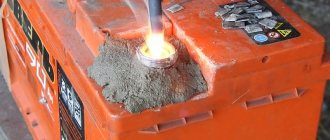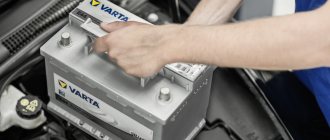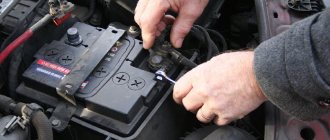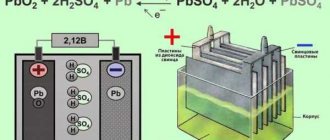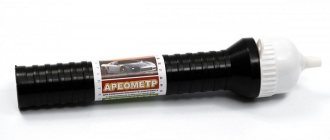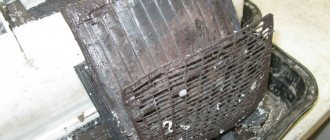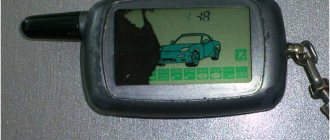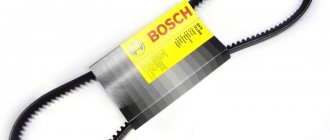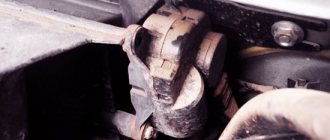To connect the battery to the vehicle's on-board network, metal contact plates with threaded fasteners are used. During operation, the nodes become deformed, which impairs the transmission of electric current. Replacing the battery terminals allows you to restore the functionality of the circuits and reduces voltage losses.
Terminals in similar or worse condition require replacement.
Causes of broken or loose terminals
- Frequent removal of the battery or “throwing away” terminals. To connect the battery to the car, terminals made of soft metals such as lead, copper, aluminum, and brass are used. Due to frequent removal and installation, their clamping force disappears, and in some cases the terminal is completely destroyed
- Too much effort
when tightening. Despite the fact that the metal is soft, when tightening too much force, the terminals can crack or break off - High heat. If there is poor contact or problems with the wiring, the terminals may become hot, causing them to become deformed.
Safety and Precautions
Before changing the terminals, you should make sure that the work will be carried out without violating safety regulations. The following points are completely unacceptable:
- Oil spill in the immediate vicinity of work.
- Presence of metal objects on the battery case.
- Insufficient lighting at the work site.
- Replacing elements while intoxicated.
If these rules are violated, very serious injuries can occur, and the ignition of fuel vapor from an accidental spark can result in a serious fire.
Consequences
Poor contact at the battery terminals leads to a decrease in the efficiency of all electrical systems of the car.
The most common problem is rapid battery drain.
when parked for a long time. At some point, the car may simply not start. Poor contact is also associated with poor operation of the starter when starting.
Oxidation of contact pair
. The formation of a white coating on the terminals and electrodes of the battery is the consequences of oxidation, which occurs from poor contact. As a result, problems arise with charging the battery while driving and its rapid discharge when parked.
Increased load on high-voltage wires
. This can lead to the wire burning out or a fire (many people cover the engine with flammable fabrics in winter).
Damage to vehicle electrical equipment
. When starting the engine, voltage surges occur, which negatively affect the devices and can damage them.
How to replace terminals on all VAZ cars?
Removal: 1. Let's start with the fact that all the terminals are made differently and they hold the wires in different ways, some in the middle part clamp the wire, and some in the side, some terminals are connected to not even one, but two or even three wires (You can see a striking example in the photo below), after you look at your terminals and understand how many wires they hold, proceed to disconnect all the wires from the terminals, the side wires are easily disconnected, just unscrew the bolts that hold them and after that removed the wires from the terminal (Bolts are indicated by red arrows), but the middle wire (the largest) is the hardest to disconnect from the terminal and there are two options, either saw it at the root (as close as possible to the terminal, in the place indicated by the blue arrow), or cut the middle part that holds the wire (see small photo), in the first case you must take into account the fact that by cutting the wire it will become shorter and therefore immediately try on whether the terminal will reach the battery terminal after it is combined with this wiring, The second option is the best, but only for it you will need additional ones. tools, because you won’t be able to cut the metal with just anything (As a last resort, try using a hammer and a large flat screwdriver; if the metal is old, it will break it and the wire will be removed, but you will only have to remove the wire completely so as not to damage the car when you hit you will hit a screwdriver with a hammer).
Installation: The hardest part is already over, installing the terminal is as easy as shelling pears, it is dismountable and you don’t need to clamp anything with any pliers, just apply a thick wire to the terminal (You need to put it in the place where the clamping bar clamps it, it is indicated by a blue arrow) and apply a clamping bar and tighten it with two bolts, which are indicated by red arrows, if you have two more wires in addition to a thick one, then each of these wires will need to be placed under the side bolts, for more details on how this is done, look at the small photo, but just take into account one more thing the fact that the bolts may be larger in diameter and the wires simply cannot be clamped, in this case, cut off the tip of the wire and remove the terminal that is not large and replace it with a new one (with an increased diameter) and everything will be fine.
Note! When you install the terminal, do not tighten it to the waist as most beginners like to do, especially for owners of domestic classics (Old classics, new injectors, this essentially doesn’t really apply, but still, anything can happen and no one is safe from fire), the terminal you need to tighten it so that it cannot be removed simply by pulling it up, but only so that by rotating it it is removed from the terminal, this is done for your own safety, if something happens, a short circuit will occur in the car, you will turn off the engine and the battery will still give current and in order to stop the supply of current to the on-board network, you will have to run for a wrench, and during this time all the wiring will burn out, and if fire or gas also gets in there, then in this case it won’t be long before there is a fire, so be careful!
Additional video clip: On any car, the terminals are replaced identically and, in fact, it doesn’t matter whether you have a VAZ or a foreign car, you just need to understand how they attach the wires and then split the terminals or cut off a little wire, you will need to disconnect the wires and replace the terminal, in more detail how You can see all this in two videos, both of which are located just below:
Selecting terminals when replacing
There are a large number of battery terminals available on the market. Before replacing the old terminal, you need to know how to select a new one.
The part must match the size of the electrodes on the battery, otherwise it will not fit or tighten. The size of the terminal should be such that when tightened tightly there is a margin of 3-5 mm.
It is also necessary to match the diameter of the hole for the high-voltage wire, which must be tightly secured in the terminal.
When choosing the material from which the terminal is made, preference is given to lead. It has good conductive properties, is soft enough for crimping and does not form a galvanic couple with the battery electrode. If you cannot find these, you can use brass or copper.
Those who use modified acoustic systems in their car, with a large number of components, should pay attention to the terminals that have additional places for attaching power wires.
There are also kits on sale that consist of a terminal with a pressed wire. This replacement option is preferable, but requires more effort.
If your car does not have a protective cover for the positive terminal, it is advisable to purchase it separately. It will protect the connection from foreign moisture, dust, as well as from accidental short circuit of the “plus” to ground.
An important role is played by the ability to quickly remove the terminals from the battery, since when carrying out repair work or a short circuit occurs in the electrical wiring, you need to turn off the power to the car.
Determination of terminal type and design
Errors when replacing terminals often occur due to incorrect identification of the type of these parts. There are several options for connecting elements that can be installed in the vehicle's electronic system:
Standard (European). Cars produced in Russia and EU countries are equipped. The diameter of such products is as follows:
- Plus – 19.5 mm.
- Minus – 17.9 mm.
When installing new products, you should also consider the polarity, which can be forward or reverse.
Asian (ASIA). Almost all cars manufactured in Asian countries are equipped with smaller terminals compared to European products. The diameter of such elements is:
- Plus – 12.7 mm.
- Minus – 11.1 mm.
Asian batteries can also be produced with different polarities.
American. They differ in design from Asian and European ones. Such products are washer-shaped connecting elements that are connected to the battery via a threaded connection. The diameter of the bolt for connecting American terminals is 12.7 mm.
Replacement
For replacement, we suggest you watch this video:
Before carrying out work, you must turn off the ignition and disconnect the battery. Most drivers know which terminal is removed first, but do not always follow this sequence. Breaking the order is important from a security point of view. If the “plus” is accidentally shorted to ground, the electronics and electrics of the car can be damaged, so first of all, the negative terminal is removed from the battery, and then the positive one.
Next, you need to remove or loosen (depending on the design) the battery mount and remove it from the “shelf”. It is strictly not recommended to replace the terminals with the battery installed!
Next, you need to disconnect the terminals from the high-voltage wires. If they are secured with a bolt clamp, then you need to loosen the tension and remove the wires. If the wires are crimped by the terminal body, use tools to loosen or completely unbend the clamp and pull out the wire.
If you cannot free the wires from the terminals, you can cut each of them and measure the length, since after cutting they may not be enough to reach the battery electrodes.
After dismantling the old terminals, you need to check the integrity of the wire insulation, and then install new ones.
The battery is connected in the reverse order - first the positive terminal, then the negative one. Before connecting, if necessary, clean the electrodes on the battery.
What could this lead to?
Worn battery terminals can cause a car fire. Internal combustion engines run on fuel that can ignite even from a small electronic discharge.
Worn parts can spark strongly, so a small amount of spilled fuel, oil or gas leak (in machines with gas-cylinder equipment) will be enough for a fire to occur.
Less dangerous, but requiring more time to troubleshoot, can also be caused by the failure of metal connecting parts.
For example, if there is insufficient contact between the terminals and the battery terminals, and with a significant electrical load (powerful audio amplifiers, air conditioning, etc.), the generator will operate in extreme mode. An increased load on this part will lead to its failure.
The inability to start the engine at any time of the year is also one of the “symptoms” of worn-out connected elements. At the same time, car owners often blame the battery for such a malfunction and even make attempts to replace the power source.
Failure to start the engine when necessary can not only result in being late for work, but can also cause serious accidents.
Replacing battery terminals
Battery terminals are contacts connecting the battery electrodes to the vehicle’s electrical network. Due to the tasks being solved, the terminal connection must be strong. Any crack, loosening of the fixed wire or deformation of the cathode lead pin can lead to disruption of the contact area or its heating with melting. Repairing a battery terminal is a simple operation. How to replace it, the sequence of operations will help you.
